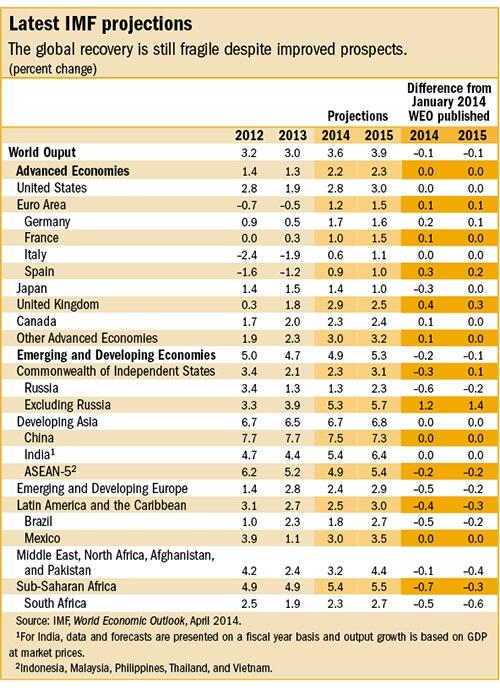Bad news from the industrial and trade sector continues.
Industrial output down 1.9% in Feb, Manufacturing falls 3.7%
Industrial production continued to slide in February, falling to a nine-month low, much below market expectations.
The Index of Industrial Production (IIP) for February fell 1.9 per cent, against a rise of 0.8 per cent in the previous month, data released by the Ministry of Statistics and Programme Implementation showed on Friday. For the April-February period of 2013-14, industrial output fell 0.1 per cent, compared with 0.6 per cent growth in the corresponding period of 2012-13.
In February, manufacturing, which accounts for 75 per cent of the index, saw a decline of 3.7 per cent in output, against halt in production in the previous month.
Mining saw growth for the fourth consecutive month, with output expanded 1.4 per cent, against 1.9 per cent in January. Power generation saw robust 11.5 per cent growth, against 6.5 per cent in January.
Capital goods output was lacklustre, with the segment contracting 17.4 per cent in February, against a fall of 4.1 per cent decline in January.
Consumer non-durable goods contracted for the first time this year, falling 1.2 per cent, against 4.6 per cent growth in the previous month. This segment was dragged down by a fall of 21.3 per cent in garments output.
The consumer durables segment, which has been contracting through 2013-14, continued to its slide, with output falling 9.3 per cent compared with 8.3 per cent in January. This led to a 4.5 per cent decline in consumer goods output in February, against a 0.5 per cent fall in January. “High retail inflation is one of the factors contributing to a deferral of purchases of big-ticket consumer durables,” said Nayar. In February, Consumer Price Index-based inflation stood at 8.1 per cent.
Imports fall 2% in March, exports see 3% decline
The economy’s woes continued in March, with imports falling 2.11 per cent compared to a year ago and exports recording a 3.15 per cent drop. However, a bigger problem lay in non-oil imports, which contracted about 12 per cent year-on-year, indicating continued slowdown in industrial activity.
The slowdown story was also evident from the foreign trade data for the entire 2013-14, released here on Friday. Exports registered growth of only four per cent, while imports saw a decline of 8.11 per cent. In absolute terms, exports stood at $312.35 billion, against $300.4 billion in 2012-13. The government had set a target of $325 billion for exports. Imports stood at $450.92 billion, against $490.73 billion in 2012-13.
The trade deficit, as a result, fell 27 per cent to $138.6 billion in 2013-14 from $190 billion in 2012-13.
According to Commerce Department data, imports fell to $40.08 billion in March from $40.94 billion in the corresponding month a year ago.
Non-oil imports declined 11.8 per cent to $24.30 billion in March from $27.53 billion a year ago. A YES Bank research estimate showed gold imports stood at $2.76 billion in March, against $3.3 billion in the corresponding month a year ago. This means non-oil, non-gold imports declined 11.10 per cent to $21.54 billion from $24.23 billion in March 2013.
“We are witnessing an industrial slowdown. There is much less demand for metals and machinery, which are raw materials for our industry,” said Madan Sabnavis, chief economist of CARE Ratings. He added the outlook didn’t seem promising till the time a new government took charge after the elections and took policy decisions to spur the economy.
Crude oil imports, however, rose 17.7 per cent to $157.83 billion in March from $134.08 billion a year ago.
Exports contracted for the second consecutive month to $29.58 billion from $30.54 billion in March 2013.
As an even more impressive achievement, car sales declined for the first time in almost 15 years:
Passenger vehicle sales dip 6% in FY14
Passenger vehicle (PV) sales in the domestic market declined for the first time in 13 years during 2013-14 (ended March 31), a drop of 6.05 per cent, despite the cuts in excise duty announced by the government in the interim budget.
Sales in the PV segment (utility vehicles and vans, excluding those of cars and sedans) had previously declined in 2000-2001, by 5.9 per cent. High interest rates, rising fuel prices and uncertain economic conditions are held to have sharply depressed demand for both PVs and commercial vehicles (CVs). Manufacturers cut output in FY14 by around five per cent and 16 per cent, respectively in each of the two segments.
According to Siam data, passenger car sales dropped for a consecutive year, by 4.65 per cent to 1,786,899 units. In 2012-13, car sales in India fell 6.7 per cent, the first decline in a decade. The CV segment showed a fall in FY14 of 20.2 per cent, at 632,738 units.
Vishnu Mathur, director-general of Siam, said: “The CV segment has seen a sales decline for over two years. The stalling of infrastructure development projects, ban in mining activities and overall slowdown in the economy has sharply affected demand. It will recover very gradually.”
During 2013-14, total sales of vehicles across categories, however, were up 3.5 per cent to 18,421,538 units as compared to 17,793,701 units in 2012-13. Volumes grew on the back of strong demand for two-wheelers, particularly scooters. Sales of two-wheelers increased by 7.3 per cent to 14,805,481 units. Demand for motorcycles grew 3.9 per cent to 10,479,817 units; those of scooters went up 23.2 per cent to 3,602,744 units.
In the current financial year, Kirloskar said the industry was “hoping for a moderate growth or at least not to be in negative territory”, provided the new government left excise duty rates unchanged.
Change cannot come soon enough. This government has been a complete disaster at managing the economy.
